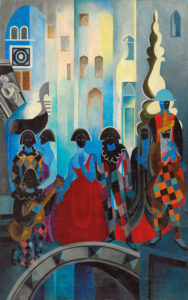Carnevale, the pre-Lenten season of extravagance, began this past weekend in Venice. There are some places in Italy where the Carnival season begins as soon as Epiphany has passed, but Venice to me always seems like the gold standard of Carnival celebrations. I love its High Baroque style: the elaborate costumes, the masks, the harlequin. It is another of the many celebrations we don’t pay much attention to here in the States, except perhaps in the cities that were settled by the French: New Orleans and Mobile come to mind, and Key West, too (and that is probably not so much a French influence but more a simple fact that the Conchs in our state’s southern-most city love a good party).
Carnevale––these days preceding Lent––is extreme in its extravagance purposefully, for the forty days of Lent that follow are extreme in the opposite direction: a season of fasting and penitence. Those forty somber days, a sort of cleansing and putting things in order, are instituted by the Church, but even without the religious aspect, some semblance of this would be necessary. Food, one must remember, was not as easy to come by in years past as it is now. Even I––and I am not that old––can remember winter, when I was a kid, being a time of canned and frozen fruits and vegetables. Imagine things a century or two ago: By this time, as winter drags on in its approach to spring, food stores would be running low and some fasting, whether penitential or not, would certainly be necessary.
But that is Lent and this is not. Before the fast comes, we are granted time to be extravagant and to celebrate and to make good use of all the things that will soon be forbidden. Carnival is a time of parades and street festivals while inside, it is a time for clearing out the larder. All the sausages, all the roasts, all the eggs, all the milk and cheese… it all had to go now.
Traditional festive foods for Carnevale vary throughout Italy, but many, especially the sweets, are fried. It is even thought that the ever popular Cannoli, the Italian dessert known around the world, originated as a Carnevale treat from Sicily. A simpler Carnevale recipe to try, and a favorite throughout Italy at this time of year, is for a delicately fried sweet called Chiacciere. They take their name from the Italian for chatter, or gossip, but we’re talking here not about gossip but about strips of lemon-scented dough, twisted and fried crisp and dusted with confectioners’ sugar. Here’s a typical recipe for Chiacciere. You’ve got some time to ponder making these treats. My sister will probably be making some before Lent begins; we’ll be enjoying them, and if you try them, too, let us know!
And so Carnevale has just begun and it will continue this year through the 13th of February, which is Shrove Tuesday, the day before Ash Wednesday, and it is Ash Wednesday that marks the beginning of Lent. Shrove Tuesday is a day to eat pancakes for supper. That is a particularly British custom, and here in this land settled first by English Puritans, this is what most Americans know about the season of Carnival. And while it is no comparison to Carnevale in Venice, still, pancakes for supper is not such a bad thing. In Italian, that day is Martedi Grosso; in French, it is Mardi Gras, and those are words we all know and associate especially with New Orleans and Mobile.
Nowadays the restrictions of Lent are pretty easy: the only hard and fast rule is no meat on Fridays. In times past, though, Lent was indeed a time of serious fasting: no meat, no eggs, no fun, no nothing. But again: these things are days and days away. For now, all we need to know is it’s time to enjoy a bit of extravagance.
SHOP OUR VALENTINE SALE!
At our online catalog right now use discount code LOVEHANDMADE to save $10 on your $85 purchase, plus get free domestic shipping, too. That’s a total savings of $19.50. Spend less than $85 and our flat rate shipping fee of $9.50 applies. If you’ve not taken a look lately at what Convivio Bookworks has to offer, I think you’ll be pleasantly surprised at what you’ll find here. Newest arrivals: Check our Specialty Foods section for some incredibly delicious chocolate we found from Iceland, including a particularly Icelandic blend of milk chocolate and licorice. If you love both these things, well… Icelanders long ago discovered that covering black licorice in milk chocolate, then dusting the result in licorice powder, is just amazing. (Trust me: we’ve gone through two bags so far.) CLICK HERE to shop; you know we appreciate your support immensely.
Image: “Carnival in Venice” by Aleksandra Exter. Oil on canvas, circa 1930s, via Wikimedia Commons.

One of my grandmothers was Lithuanian and every Christmas she made something very much like Chiacchiere. I don’t know what they were called, their history, or lore, but other Eastern European people have similar treats. I don’t know if they originated as a treat for Carnevale or not, but we had them for breakfast every Christmas morning. Grandma is long gone and no one seems to have her recipes. I’m going to try to make some Chiacchiere to celebrate Carnevale and remember grandma and those long ago Christmases.
Scott, that sounds like the perfect thing to do. I’m so glad these little chiacchieri reminded you of your grandma.